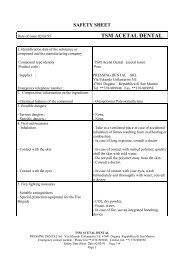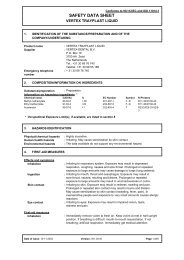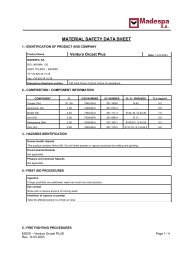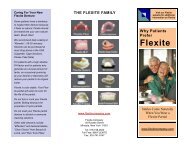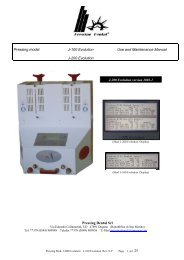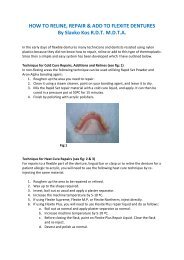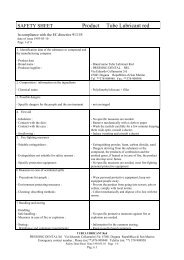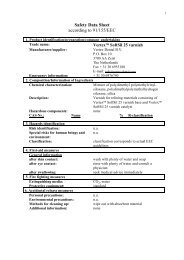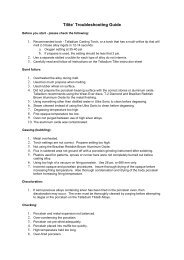MATERIAL SAFETY DATA SHEET - Talladium UK
MATERIAL SAFETY DATA SHEET - Talladium UK
MATERIAL SAFETY DATA SHEET - Talladium UK
You also want an ePaper? Increase the reach of your titles
YUMPU automatically turns print PDFs into web optimized ePapers that Google loves.
<strong>MATERIAL</strong> <strong>SAFETY</strong> <strong>DATA</strong> <strong>SHEET</strong><br />
CHEMICAL SUBSTANCES AND PRODUCTS<br />
ACCORDING DIRECTIVE 91/155/EEC<br />
date: March 2007 version: 7 author: GM<br />
1 IDENTIFICATION OF THE PRODUCT AND COMPANY<br />
1.1 product name: VERTEX Acrybond liquid<br />
chemical characterisation:<br />
Monomer based on Methyl methacrylate. CH 2 =C(CH 3 )COOCH 3<br />
1.2 Manufacturer: Vertex-Dental B.V.<br />
PO Box 10<br />
3700 AA ZEIST<br />
The Netherlands<br />
1.3 emergency telephone number: + 31 30 6976749<br />
2 COMPOSITION AND INFORMATION ON INGREDIENTS<br />
components label CAS no. [%] MAC [ppm]<br />
Methyl methacrylate X i , F 80-62-6 > 50 10<br />
Acetone X i 67-64-1 < 50 500<br />
Occupational Exposure Limit(s) ,if available, are listed in section 8<br />
3 HAZARDS IDENTIFICATION<br />
3.1 routes of entry:<br />
Methyl methacrylate and Acetone is absorbed into the body by inhalation, swallowing and<br />
through the skin. A for the health harmful concentration in the air, is quickly reached at a<br />
temperature of 20°C.<br />
3.2 carcinogenic aspects:<br />
None of the components of this product are listed by IARC, NTP, OSHA or ACIGH as<br />
carcinogens.<br />
3.3 maximum concentration at workplace (MAC):<br />
For methyl methacrylate: 10 ppm = 40 mg/m 3<br />
For Acetone<br />
500ppm = 1200 mg/m³<br />
3.4 effects short-term:<br />
Liquid or high vapour concentration can irritate eyes and respiratory system and cause skin<br />
rashes.<br />
3.5 effects long-term, repeated exposure:<br />
Prolonged exposure can lead to headaches, nausea, drowsiness and unconsciousness. Repeated<br />
and prolonged overexposure may cause permanent allergic skin rashes.<br />
1
4 FIRST AID MEASURES<br />
4.1 inhalation:<br />
Remove to fresh air, rest, sit half way up. Get medical help if discomfort persist.<br />
skin:<br />
Remove contaminated clothing. Wash thoroughly with soap and water.<br />
eyes:<br />
Flush thoroughly with water for 15 minutes and contact a doctor.<br />
ingestion:<br />
Wash out the mouth and transport immediately to a hospital.<br />
5 MEASURES IN CASE OF FIRE<br />
5.1 flash point: 10°C<br />
5.2 explosion limits: air vol.% lower: 2.1 %<br />
upper: 12.5 %<br />
5.3 auto ignition temperature: 430°C<br />
5.4 extinguisher method:<br />
useful: Powder, A.F.F.F., foam and carbon dioxide.<br />
not useful: Direct jet of water.<br />
5.5 hazardous decomposition products: none<br />
5.6 hazardous reactions:<br />
When heated above the flash point, flammable vapours are emitted which can mix with air and<br />
can burn or be explosive. Vapours are heavier than air and may travel to the source of ignition<br />
and flash back. Heat can cause polymerisation with rapid release of energy which may rupture<br />
container explosively.<br />
6 ACCIDENTAL RELEASE MEASURES<br />
6.1 leakage / spillage:<br />
Warn bystanders. Eliminate sources of ignition. Prevent monomer from entering drains or<br />
water sources. Collect liquid in a open barrel. Absorb spilled liquid with inert material as dry<br />
earth or other absorbent material and transfer to a save place for disposal.<br />
See point 13 for disposal of the liquid.<br />
6.2 personal precautions:<br />
See point 8 for personal protection.<br />
6.3 environmental precautions:<br />
See point 12 for information concerning the environment.<br />
2
7 HANDLING AND STORAGE<br />
7.1 handling:<br />
Work in a well ventilated place. Material is inflammable, it must be kept away from naked<br />
flames or other sources of ignition. Keep away from food, drinks, and animal feed.<br />
7.2 storage:<br />
Store in a cool dark place, separated from oxidising agents. Container may be filled only for 80<br />
%. Keep container tightly closed to avoid evaporation of the product.<br />
7.3 protection against fire and explosion:<br />
Keep out of direct sunlight or any source of heat, sparks or flame. Take measures against the<br />
build-up of electrostatic charges. In case of fire, keep any closed container of monomer cool by<br />
using a fine water spray if they cannot be moved away.<br />
8 PERSONAL PROTECTION<br />
8.1 respiratory protection:<br />
Local exhaust ventilation or an adequate mask with a filter useful for organic vapour (type<br />
A 2 B 2 ). Possible a half-mask with active carbon may be used (FHMPE).<br />
hand protection: Polyvinylalcohol gloves. Warning: PVA is soluble in water!<br />
eye protection: Protecting glasses.<br />
other protection: None.<br />
8.2 industrial hygiene:<br />
Keep working clothes separately. Take off contaminated clothing immediately. Keep away<br />
from food, drinks and animal feed.<br />
9 PHYSICAL AND CHEMICAL PROPERTIES<br />
9.1 appearance: colourless, clear liquid<br />
9.2 odour: ester like<br />
9.3 pH: not applicable<br />
9.4 boiling point: 56 – 101 °C<br />
9.5 melting point: -95 - -48 ° C<br />
9.6 flash point: Metthyl methacrylaat 10 °C<br />
Acetone -19 °C<br />
9.7 auto ignition temperature: 430°C<br />
9.8 explosive properties: yes, see point 5.2<br />
3
9.9 oxidising properties: not applicable<br />
9.10 vapour pressure: 47 mbar (at 20°C) Methyl methacrylaat<br />
233 mbar (Acetone)<br />
9.11 relative density: 0.85 (water = 1)<br />
9.12 water solubility: 1.5 g / 100 ml (at 20°C)<br />
9.13 viscosity: 0.6 mPa×s<br />
10 STABILITY AND REACTIVITY<br />
10.1 stability:<br />
The liquid is stabilised with Hydroquinone (CAS-regnr. 123-31-9). However polymerisation<br />
may occur when the expiry date and/or storage temperature is considerable exceeded.<br />
10.2 hazardous reactions:<br />
When heated above the flash point, flammable vapours are emitted which can mix with air and<br />
can burn or be explosive. Vapours are heavier than air and may travel to the source of ignition<br />
and flash back. Heat can cause polymerisation with rapid release of energy which may rupture<br />
container explosively.<br />
10.3 hazardous decomposition products:<br />
By use according the instructions; none.<br />
11 INFORMATION ON TOXICITY<br />
According to literature.<br />
Methyl methacrylate is essentially non toxic when absorbed into the body by any route, but for some<br />
few individuals is a powerful skin sensitiser. Apart from this skin allergy, human cases of ill health<br />
caused by material are of a low probability.<br />
Long-term inhalation test on rats and hamsters with exposure concentrations ranging from 100 to 400<br />
ppm did not show any chronic toxic effects. However concentrations on excess of 100 ppm volume<br />
may be irritating for some people. Handling of the product requires adequate ventilation to prevent<br />
accumulation of vapours in work areas.<br />
11.1 Methyl methacrylate:<br />
Acute oral rat:<br />
Acute skin rabbit:<br />
Acute inhalation rat:<br />
LD 50 = 7872 mg/kg<br />
LD 50 =>5000 mg/kg<br />
LC 50 = 78000 mg/m³ /4 hours<br />
Human patch test:<br />
Approximate one-third of subjects developed mild redness at site of application. Twenty<br />
percent showed sensitivity when tested 10 days later.<br />
4
11.2 Acetone:<br />
Acute oral rat:<br />
Acute skin rabbit:<br />
Acute inhalation rat:<br />
12.1 Methyl methacrylate<br />
Ecotoxicity:<br />
Acetone:<br />
Ecotoxicity:<br />
LD 50 = 5800 mg/kg<br />
LD 50 = 2000 mg/kg<br />
LC 50 = 50.1 g/m³ /4 hour<br />
LC 50 = ( fish, 96 hour): 130 mg/l<br />
EC 50 = (Daphnia magna, 24 hour) 720 mg/l<br />
LC 50 = ( fish, 96 hour): 5540 mg/l<br />
EC 50 = (Daphnia magna, 48 hour) 9218 mg/l<br />
Human patch test:<br />
Approximate one-third of subjects developed mild redness at site of application. Twenty<br />
percent showed sensitivity when tested 10 days later.<br />
13 DISPOSAL CONSIDERATIONS<br />
Methods of disposal.:<br />
Disposal according to the local legislation<br />
Waste of residues<br />
Keep waste separate. Because of possible pollution, remove as<br />
industrial waste or hazardous waste<br />
Contaminated packaging Keep waste packaging separate. Because of possible pollution ,<br />
remove as industrial waste or hazardous waste<br />
14 TRANSPORT<br />
14.1 UN no.: 1247<br />
14.2 Land –Road /Rail and inland waterways:<br />
Un. : 1247<br />
Proper shipping name : Methyl methacrylate monomer stabilized<br />
ADR/ADNR Rid class : 3<br />
Packing group<br />
: II<br />
Hazard Identification : 339<br />
Tremcard : 30G30.<br />
Tank lorry RN 10500: 339/1247<br />
14.3 transport through the air:<br />
UN no./ID no : 1247<br />
ICAO/IATA class : 3<br />
Packing group air : II<br />
Proper shipping name : Methyl methacrylate, monomer stabilized<br />
14.4 transport by sea:<br />
UN IMDG : 1247<br />
IMDG classs : 3<br />
Packing group sea : II<br />
EmS : 3-07<br />
MFAG :330<br />
5
Technical name:<br />
: Methyl methacrylate, monomer stabilized<br />
14.6 further information:<br />
The product contains more than 50 % methyl methacrylate, monomer, stabilised by<br />
Hydroquinone.<br />
Registration EC list hazardous material:<br />
Methyl methacrylate 607-035-00-6<br />
Acetone 606-001-00-8<br />
15 REGULATORY INFORMATION / LABELS<br />
Methyl methacrylate, the crosslinker, accelerator and UV absorber are subjected to the law<br />
environmental dangerous substances concerning information according packing and labelling.<br />
15.1 hazard category:<br />
The product is subjected to mandatory marking in accordance with the law environmental<br />
dangerous substances.<br />
F highly flammable<br />
irritating<br />
X i<br />
15.2 risk phrases:<br />
R 11<br />
R 36/37/38<br />
R 43<br />
Highly flammable<br />
Irritating to eyes, respiratory system and skin<br />
May cause sensitisation by skin contact<br />
15.3 safety phrases:<br />
S 9 Keep container in well ventilated place<br />
S 16 Keep away from ignition sources - no smoking -<br />
S 29 Do not empty into drains<br />
S 33 Take precautionary measures against static discharges<br />
16 FURTHER INFORMATION<br />
The product may at heat development, polymerise spontaneously when the expiry date and/or the<br />
storage temperature is considerable exceeded.<br />
When pouring the liquid into smaller containers, use dark glass bottles or aluminium containers only.<br />
Do not use transparent containers. Also check the labelling on the new containers concerning the<br />
hazard category and the risk and safety phrases.<br />
All information is based on the present state of knowledge and experience. The material safety data<br />
sheet serves to describe the product only with regard to safety requirements. Vertex-Dental BV can not<br />
been held responsible for the completeness of this material safety data sheet.<br />
6



